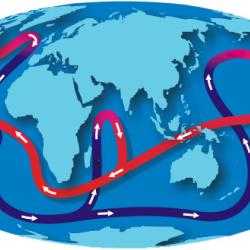Source Institutions
Source Institutions
Add to list Go to activity
Activity link broken? See if it's at the internet archive

In this quick activity, learners observe how salinity and temperature affect the density of water, to better understand the Great Ocean Conveyor. Learners observe what happens when they add freshwater and saltwater ice cubes to a fishbowl nearly full of water. A brief explanation included in this resource explains why the ice cubes behave differently and how it relates to the motion of the Great Ocean Conveyor. This resource also explains how thunderstorms relate to air density and how to keep safe during a storm.
- 4 to 24 hours
- 5 to 10 minutes
- 1 cent - $1 per group of students
- Ages 6 - 14
- Activity, Demonstration, Lesson/Lesson Plan
- English
Quick Guide
Materials List (per group of students)
- Fish bowl (or large, deep glass container such as fish tank, bowl, or pitcher)
- Food coloring
- Table salt
- Ice cube tray
- Water
Subjects
-
Earth and Space Science
-
Earth Processes
- Weather and Climate
-
Earth Structure
- Oceans and Water
- Atmosphere
-
Earth Processes
-
Physical Sciences
-
Heat and Thermodynamics
- Heat and Temperature
-
Chemistry
- Solutions
-
States of Matter
- Liquids
- Gases
- Changes of Phase
-
Structure and Properties of Matter
- Volume and Density
-
Heat and Thermodynamics
-
The Nature of Science
-
The Scientific Process
- Conducting Investigations
- Formulating Explanations
-
The Scientific Process
Informal Categories
- Nature and Environment
Audience
To use this activity, learners need to:
- see
- see color
- touch
Learning styles supported:
- Involves hands-on or lab activities
Other
This resource is part of:
Access Rights:
- Free access
By:
Rights:
- All rights reserved, National Weather Service,
